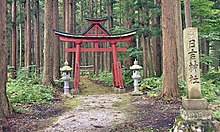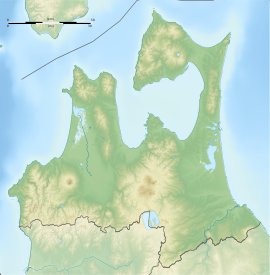76:
48:
83:
55:
31:
376:
362:
315:
of the
Hiyoshi Taisha was referred to as "Sannō Gongen", and the shrine has a tradition that a Buddhist temple called Aun-ji (阿吽寺) was once located nearby. The temple was destroyed by the
338:, Oku-no-in, and several smaller structures. The age of these foundations range from the mid-14th century to the mid-15th century. During this period, this area was controlled by the
75:
464:
132:
389:
322:
Excavations thus far have revealed the foundation stones of several buildings preserved in very good condition, including the foundations of the
479:
319:
when they conquered his area in 1443, and had never been rebuilt, although its location had been preserved by the shrine as a sacred site.
47:
489:
327:
469:
484:
268:
347:
474:
438:
245:
241:
106:
30:
343:
210:
446:
288:
249:
261:
253:
180:
120:
264:
367:
300:
296:
458:
305:
292:
280:
381:
284:
409:
339:
357:
316:
346:
and the layout is similar to contemporary temple layouts in Kyoto during the
147:
134:
334:
303:. Under the pre-Meiji period amalgamation of Buddhism with Shintoism (
323:
257:
110:
311:
295:, the Goshogawara Hiyoshi Jinja which is a branch of the famous
291:
in a forested valley near the Sannobō River. The site has a
199:
191:
186:
176:
171:
163:
126:
116:
102:
231:
225:
279:The site is located on the northern shore of
8:
16:
416:(in Japanese). Agency for Cultural Affairs
29:
15:
390:List of Historic Sites of Japan (Aomori)
401:
465:Buddhist archaeological sites in Japan
7:
271:in 2017 by the Japanese government.
82:
54:
14:
267:. The remains were designated a
374:
360:
81:
74:
53:
46:
439:Aomori Prefecture official site
211:National Historic Site of Japan
447:Goshogawara City official site
342:, who had close ties with the
287:, almost in the center of the
62:Shown within Aomori Prefecture
1:
65:Show map of Aomori Prefecture
480:History of Aomori Prefecture
244:in what is now the city of
232:
506:
260:containing the ruins of a
203:Yes (no public facilities)
226:
207:
40:
35:Goshogawara Hiyoshi Jinja
28:
21:
414:Cultural Heritage Online
490:Historic Sites of Japan
350:and Muromachi periods.
269:National Historic Site
148:41.06528°N 140.36806°E
90:Sannobō Site (Japan)
242:archaeological site
153:41.06528; 140.36806
144: /
107:Goshogawara, Aomori
18:
344:Ashikaga Shogunate
200:Public access
289:Tsugaru Peninsula
250:Aomori Prefecture
218:
217:
93:Show map of Japan
497:
470:Muromachi period
451:
443:
426:
425:
423:
421:
406:
384:
379:
378:
377:
370:
365:
364:
363:
262:Muromachi period
239:
238:
235:
229:
228:
181:Muromachi period
159:
158:
156:
155:
154:
149:
145:
142:
141:
140:
137:
94:
85:
84:
78:
66:
57:
56:
50:
33:
19:
505:
504:
500:
499:
498:
496:
495:
494:
455:
454:
449:
441:
435:
430:
429:
419:
417:
408:
407:
403:
398:
380:
375:
373:
366:
361:
359:
356:
277:
265:Buddhist temple
236:
223:
214:
213:
152:
150:
146:
143:
138:
135:
133:
131:
130:
98:
97:
96:
95:
92:
91:
88:
87:
86:
69:
68:
67:
64:
63:
60:
59:
58:
36:
24:
12:
11:
5:
503:
501:
493:
492:
487:
485:Mutsu Province
482:
477:
472:
467:
457:
456:
453:
452:
444:
434:
433:External links
431:
428:
427:
400:
399:
397:
394:
393:
392:
386:
385:
371:
368:History portal
355:
352:
297:Hiyoshi Taisha
276:
273:
233:Sannobō iseki
221:Sannobō ruins
216:
215:
209:
208:
205:
204:
201:
197:
196:
193:
189:
188:
184:
183:
178:
174:
173:
169:
168:
165:
161:
160:
128:
124:
123:
118:
114:
113:
104:
100:
99:
89:
80:
79:
73:
72:
71:
70:
61:
52:
51:
45:
44:
43:
42:
41:
38:
37:
34:
26:
25:
22:
13:
10:
9:
6:
4:
3:
2:
502:
491:
488:
486:
483:
481:
478:
476:
473:
471:
468:
466:
463:
462:
460:
450:(in Japanese)
448:
445:
442:(in Japanese)
440:
437:
436:
432:
415:
411:
405:
402:
395:
391:
388:
387:
383:
372:
369:
358:
353:
351:
349:
345:
341:
337:
336:
331:
330:
325:
320:
318:
314:
313:
308:
307:
306:Honji suijaku
302:
298:
294:
293:Shinto Shrine
290:
286:
283:, facing the
282:
274:
272:
270:
266:
263:
259:
255:
254:Tōhoku region
251:
247:
243:
234:
222:
212:
206:
202:
198:
194:
190:
185:
182:
179:
175:
170:
166:
162:
157:
129:
125:
122:
121:Tōhoku region
119:
115:
112:
108:
105:
101:
77:
49:
39:
32:
27:
20:
17:Sannobō ruins
418:. Retrieved
413:
404:
382:Japan portal
333:
328:
321:
310:
304:
285:Sea of Japan
278:
256:of northern
220:
219:
167:temple ruins
475:Goshogawara
420:25 February
348:Nanboku-chō
301:Ōtsu, Shiga
246:Goshogawara
151: /
139:140°22′05″E
127:Coordinates
459:Categories
396:References
324:South Gate
317:Nanbu clan
281:Lake Jūsan
187:Site notes
136:41°03′55″N
340:Andō clan
252:, in the
192:Condition
354:See also
275:Overview
103:Location
309:), the
177:Periods
172:History
410:"王坊遺跡"
240:is an
117:Region
335:Kairō
329:Hondō
258:Japan
227:山王坊遺跡
195:ruins
111:Japan
23:山王坊遺跡
422:2020
312:kami
164:Type
299:in
461::
412:.
332:,
326:,
248:,
230:,
109:,
424:.
237:)
224:(
Text is available under the Creative Commons Attribution-ShareAlike License. Additional terms may apply.


